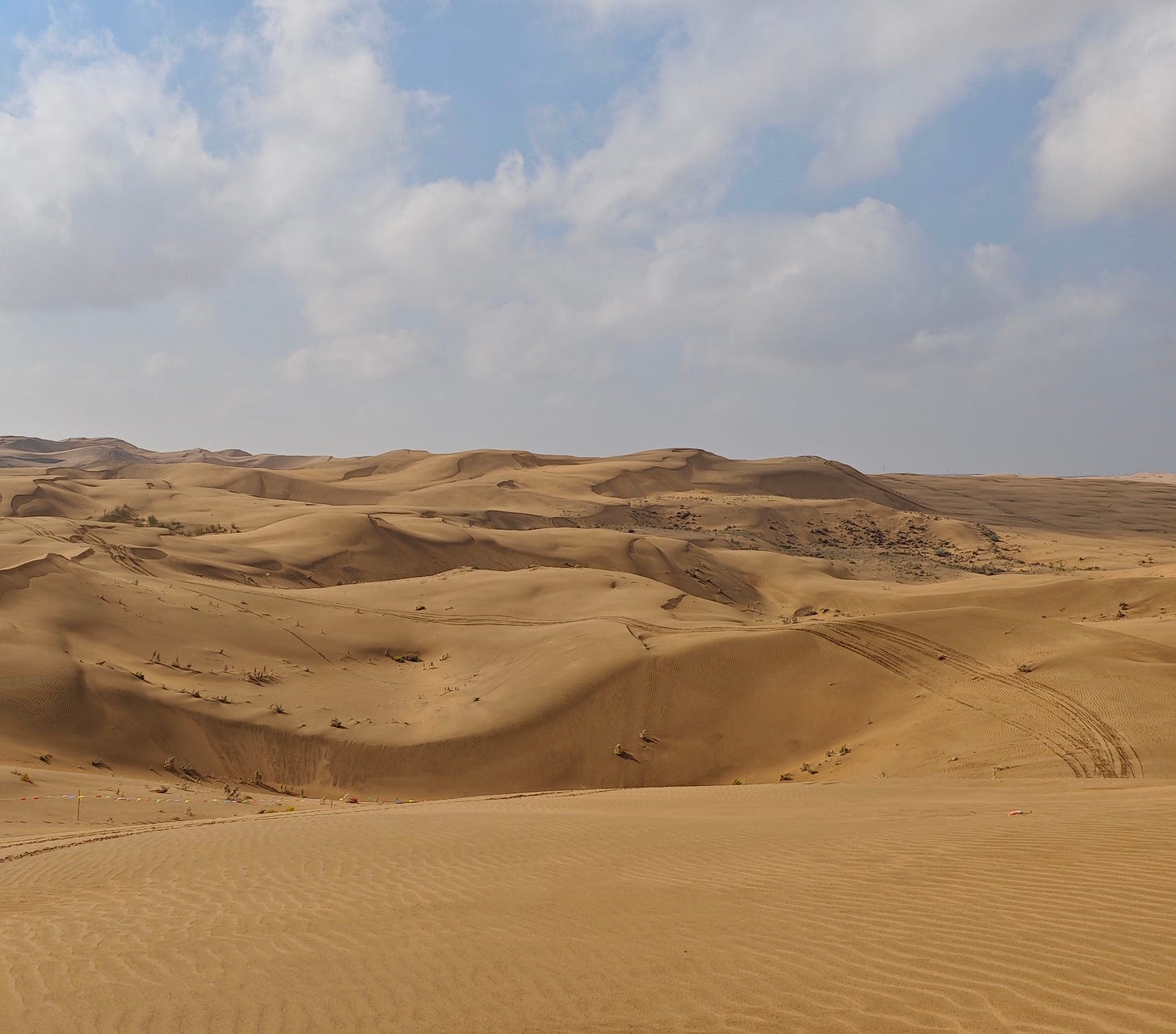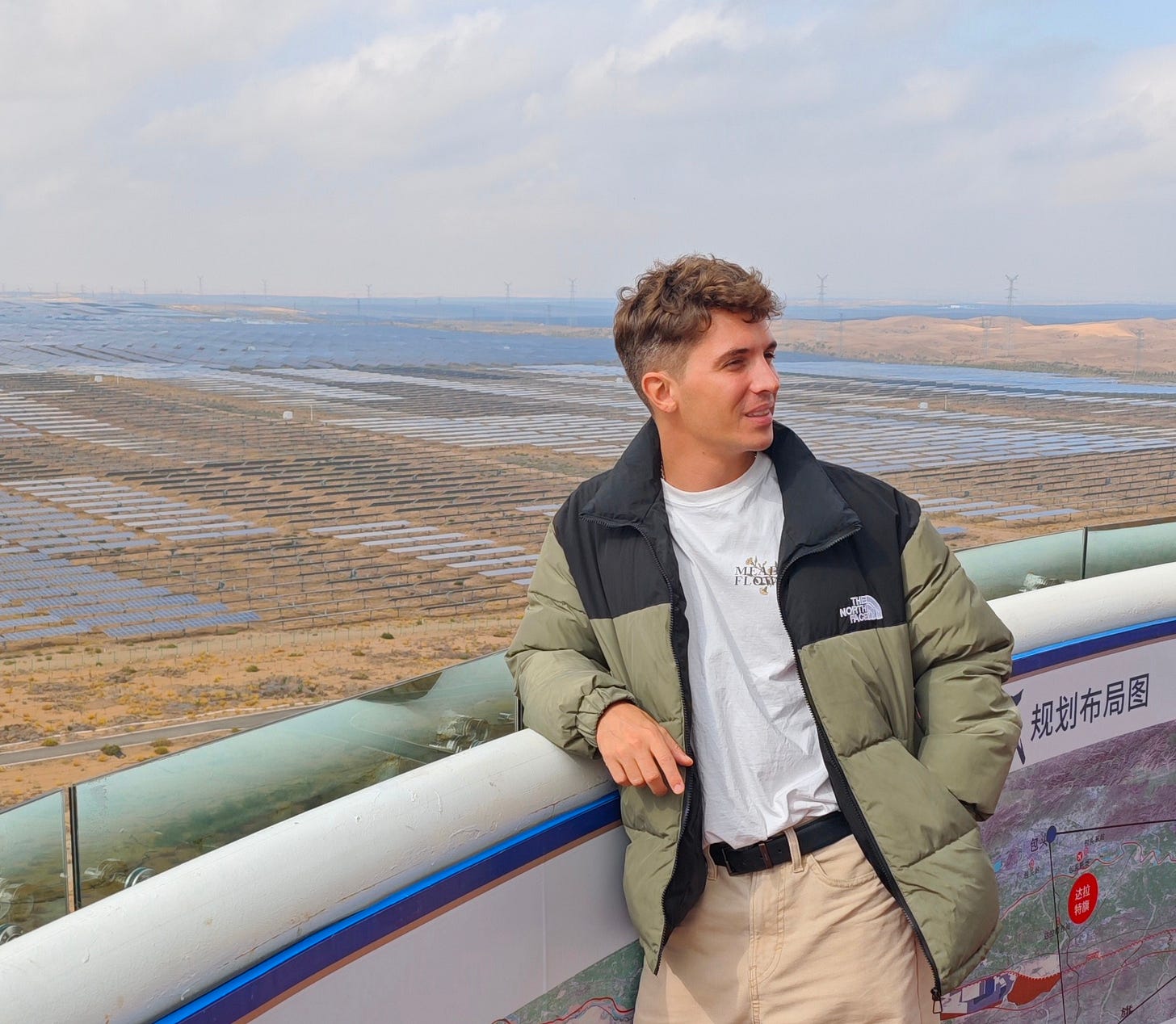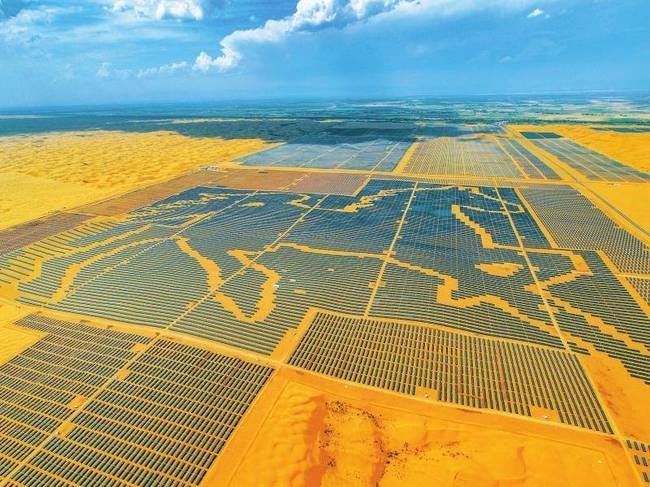The vast northwest, the lung of China's renewables
Megaprojects: renewable energy across the deserts, loess, and steppes of northwest China.
[Intro]
China is often portrayed as one of the world's most polluting countries and holds the record for the highest total emissions globally. However, it is also the nation that invests and innovates the most in renewable energy, including wind farms, hydropower, and, above all, photovoltaic plants. This dual identity as both a major polluter and a leader in renewable energy is often misunderstood and calls for deeper study and analysis. The ongoing innovation and rapid changes demand continuous cataloging and monitoring.
ElectroChina aims to bring public attention to innovations and developments in photovoltaic technology, with a focus on China.
[My Journey to Kubuqi, Ordos, Inner Mongolia]
Last month, I had the privilege of visiting one of the largest photovoltaic parks in the world, located in the Kubuqi Desert, just north of the city of Ordos in Inner Mongolia. Once fully completed, the project is expected to reach a total capacity of 16 GW.
The desert, the seventh largest in China, acts as a natural divide between the central-northern loess plateaus of Shaanxi—famous for Mao Zedong's guerrilla strongholds like Yan'an and Yulin—and the vast, green highlands of Inner Mongolia. These arid, sparsely populated regions remain a geographical and anthropological boundary, historically separating the nomadic and sedentary cultures that have inhabited the areas between northern Shaanxi (陕西) and southwestern Inner Mongolia (内蒙古).
In mid-October, I found myself in that area, and driving along the edges of the desert, I was captivated by the boundless nature of those regions. Many things caught my attention and left a lasting impression, inspiring me to write a short article with some reflections!
[Where I’ve Been?]
Amid the pale, undulating dunes of the Kubuqi Desert, one can see the anthropological footprint of the "Three Norths" project—an initiative named after the three geographic regions of northern China (in Chinese: Dongbei 东北, Huaibei 华北, Xibei 西北). Launched in 1979, this monumental project aims to combat desertification and reforest arid, sun-scorched areas by 2050. Spanning an incredible 71 years, the project involves four generations of tree planters!
Known in less militaristic terms as The Great Green Wall of China or The Three-North Shelterbelt Program, this effort stretches from the northeastern plains (Dongbei 东北) in Heilongjiang 黑龙江, near the border with the Korean Peninsula, to the deserts of the northwestern region (Xibei 西北) in Xinjiang 新疆. The initiative seeks to stabilize vast plains and fragile loess valleys with trees and various shrubs, aiming to slow the relentless advance of the sands.
These wind-eroded and overgrazed areas have, over the past centuries, turned into vast expanses where the desert relentlessly advances, impoverishing the remaining few communities. Occasionally, this even triggers full-blown sandstorms that reach major cities like Beijing, Xi'an, and others in inner China.
Beyond the massive efforts to plant pines and shrubs, solar energy—through photovoltaic parks—has become one of the new strategies to halt the desert’s advance. The government is striving to align renewable energy initiatives with the Three-North program.
During my brief stay in Kubuqi, I observed vast stretches of solar panels. The modules are arranged in rows of about thirty units each, rotating almost imperceptibly in the silent desert to track the sun's angle. If you listen closely, you can hear millions of gears turning in sync with the sun, producing a continuous ticking sound.
The modules provide shade, creating optimal conditions for the development of a favorable microclimate and reducing soil surface temperatures. Beneath the shadow of millions of photovoltaic cells, roots grow, laying the groundwork for life. Pastures are given a chance to recover, and small shrubs climb the metal foundations of the structures.
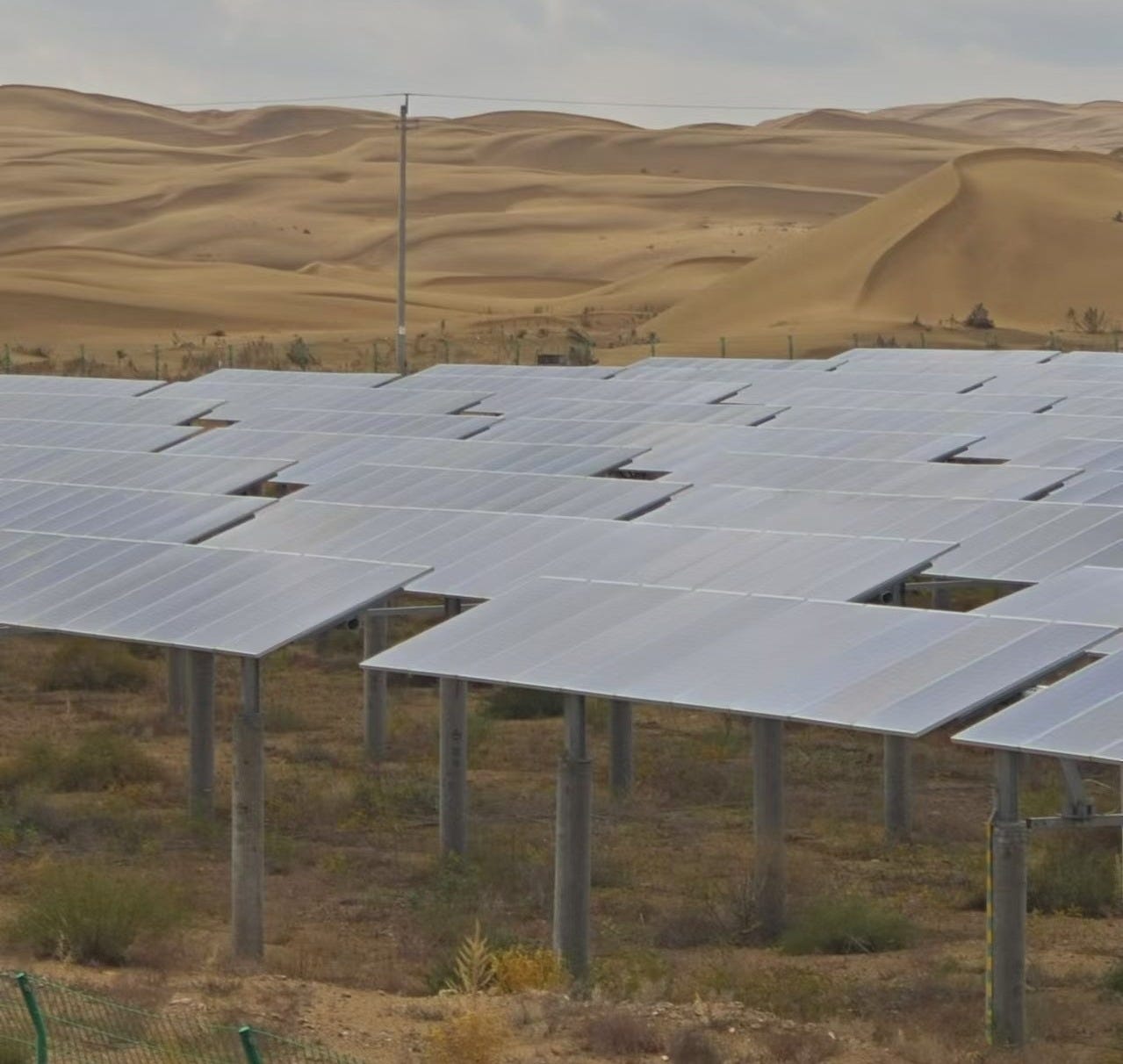
[The Role of Solar Energy in Kubuqi]
Here, in Kubuqi and the northwest regions (Ningxia, Qinghai), solar energy has found an ideal setting: vast levels of solar irradiation (see image down), wide, sparsely populated areas (see Heihe-Tengchong line image), and, finally, the need to combat the desert's advance (dual use, electricity production and desertification barrier).
However, it is important to emphasize that the real challenge lies in finding a practical use for this green energy, as it is often consumed and lost due to the lack of productive activities or local storage methods. The northwestern regions are rich in energy resources (coal, oil, wind, solar irradiation), but they have fewer industries and economic activities where the excess energy can be directed. In contrast, the eastern regions are significantly more developed and have a high demand for affordable electricity.
To address this, there are generally two major trends:
[1] Local Energy Utilization (in Chinese: 就地消纳). The government is working to shift high electricity-intensive industrial production from the eastern regions to the more central and western areas or to a smart power grid that connects supply and demand across vast areas of the territory (see the "1469" strategy of Inner Mongolia Electric Power Group).
[2] Delivering Electricity to the East (in Chinese: 西电东送), where it can be consumed by industrial activities or individual users in more densely populated areas.

Let's expand a bit on these points with some reflections:
Regarding local consumption of renewable energy:
[1] During my stay in Ordos, I noticed how many companies from other parts of China have decided to set up their energy-intensive production lines in these regions. For example, LONGi Green Energy, a major manufacturer of photovoltaic cells, has part of its production in Ordos. In the past, other energy-heavy industries, such as bitcoin miners (e.g., BITMAIN), have also thrived on the area's low energy prices. It should be noted that much of this energy usage still comes from coal-fired power plants, but it is precisely here—where energy prices are low—that a green revolution is unfolding.
Regarding transporting energy directly to consumers in the East:
[2] The second plan mentioned above is a marvel of engineering, designed to transport low-cost (both renewable and non-renewable) energy produced in the western regions to the more populated and productive central and southeastern regions, such as Henan (河南), Jiangsu (江苏), and Zhejiang (浙江). This plan is officially known as “Energy from the West to the East” (西电东送) and is less formally referred to as “The Electricity Highway” (电力高速公路). This energy transport system uses a technology known as UHV (Ultra High Voltage electricity transmission). High-voltage transmission systems currently achieve only a 1.6% loss every 1,000 kilometers, maintaining high voltage throughout the entire transmission from pylon to pylon. That’s why it’s called "The Electricity Highway." These megaprojects are an economic tool for the Chinese government to achieve several goals, including "The Development of the Great West" (西部大开发), economic and energy development along the Belt and Road Initiative (一带一路能源合作) and more generally, the ambitious goal to reach carbon emissions peak by 2060, also known as the "carbon peaking and carbon neutrality goals" (双碳目标). The green transition from coal to renewable energy, as well as the fight against desertification, are fundamental principles underlying the economic activities and local community development in this region, and they work in perfect synergy in this context.
[Conclusion]
To achieve its carbon emissions targets by 2060, China must significantly increase the share of renewable energy in its energy mix. A key strategy for this is to transport some of the green energy produced in the west to the east. However, from 2000 to 2010, the so-called "electric highways" project focused primarily on traditional, low-cost energy sources, such as coal. Until just a few years ago, most renewable energy was produced in hydroelectric basins, using turbines in the hundreds of dams in the southwestern regions (e.g., Sichuan 四川, Yunnan 云南).
However, in the past decade, with the rapid rise of China's photovoltaic sector and the decreasing price of silicon, conditions have emerged to develop massive solar power plants reaching capacities of many gigawatts (e.g., Kubuqi project, Ningxia, etc.). To date, there are already 39 high-voltage transmission line projects in place, with many more under construction.

Attention!
Most of the projects are still based on non-renewable energy sources, but the reality is slowly changing through actions driven by the government (state-owned enterprises) and market tools such as the CETS (National Carbon Market), which are guiding major investment centers to focus on renewable energy sources to incorporate into their energy production mix.
The question I asked myself is: Which of the two solutions is more cost-effective in the long term?
[东产西移] Moving part of the production from the east directly to the northwest and using the local energy grid to save on energy costs?
[西电东送] Transporting the energy produced in the west to the east via huge energy highways (UHV)?
[Appendix]
At the center of the sea of photovoltaic panels stands a metal installation, as tall as a 5-6 story building. As you ascend to the top of this structure, the successes and grand plans of the Chinese government for the entire area where the solar park extends are displayed on either side of the stairs. From above, you can faintly make out the shape of a horse etched into the desert, like a mosaic made of millions of tiles.
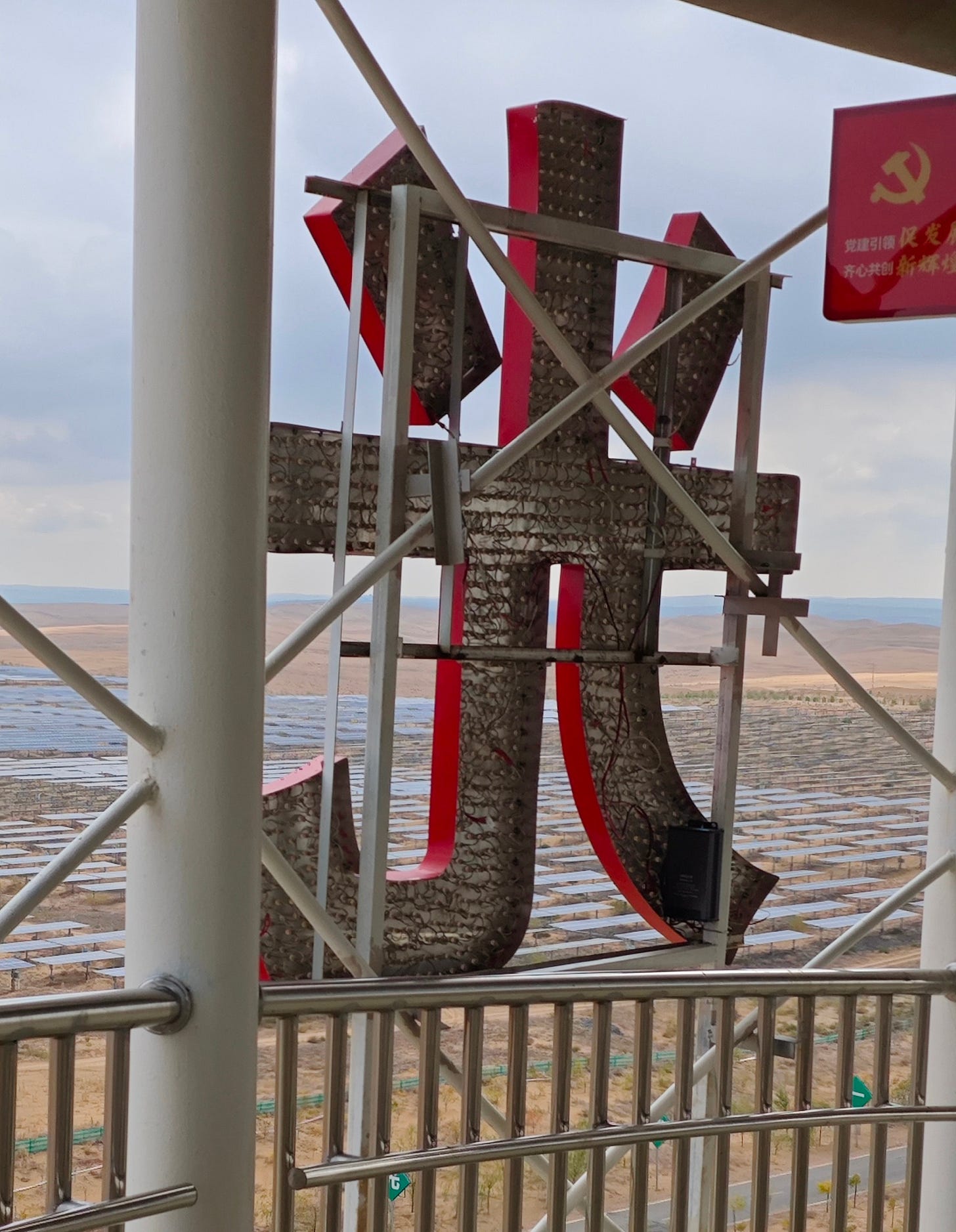
[Website and Documents]:




